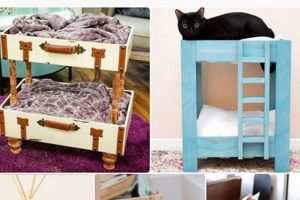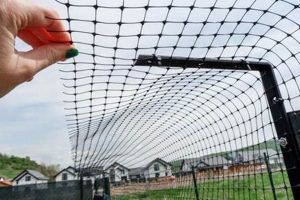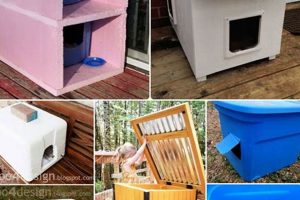A self-constructed, durable shelter designed to protect domestic felines from inclement weather conditions when residing outdoors represents a practical solution for pet owners. This type of structure offers protection from rain, snow, wind, and extreme temperatures, providing a safe and comfortable haven for animals. For example, such a construction might involve using insulated materials and a raised floor to maintain warmth and dryness within the shelter.
Providing this type of protective structure is critical for ensuring the health and well-being of outdoor cats, particularly during harsh seasonal changes. It minimizes the risk of hypothermia, frostbite, and other weather-related ailments. Historically, pet owners have sought ways to provide outdoor animals with adequate protection, and this represents a continuation of that practice, adapted to modern materials and construction techniques. These shelters contribute significantly to animal welfare by offering a secure refuge.
The subsequent discussion will delve into material selection, construction techniques, insulation methods, and design considerations essential for building a robust and effective protective shelter for outdoor cats. Topics such as ventilation, entry design, and placement will also be addressed to optimize the shelter’s functionality and appeal to feline occupants.
Essential Considerations for Constructing a Durable Outdoor Feline Shelter
The following recommendations provide critical guidance for the successful creation of a long-lasting and weather-resistant outdoor shelter for felines, ensuring their safety and comfort in varied environmental conditions.
Tip 1: Material Selection: Prioritize weather-resistant materials such as treated lumber, exterior-grade plywood, or durable plastics for the structural components. Avoid materials prone to rot, mold, or water damage.
Tip 2: Insulation is Key: Incorporate insulation within the walls, floor, and roof to regulate temperature extremes. Rigid foam insulation or fiberglass batting can provide effective thermal protection. Ensure the insulation is protected from moisture.
Tip 3: Waterproofing Measures: Apply sealant to all seams and joints to prevent water infiltration. Consider a waterproof membrane beneath the roofing material for added protection against rain and snow.
Tip 4: Elevated Base: Construct the shelter with a raised base to prevent ground moisture from seeping into the structure. This also helps to maintain a consistent temperature within the shelter.
Tip 5: Entrance Design: Design the entrance to minimize wind and rain exposure. An offset or tunnel-style entrance can effectively block drafts while allowing easy access for the feline occupant.
Tip 6: Ventilation Considerations: Incorporate ventilation to prevent moisture buildup and maintain air quality within the shelter. Small, covered vents can provide adequate airflow without compromising weather protection.
Tip 7: Roof Slope and Overhang: Design the roof with a slope to facilitate water runoff. An overhang can further protect the entrance from rain and snow.
These guidelines collectively ensure a structure that effectively protects felines from the elements, promoting their health and well-being in outdoor environments.
The following section will address specific design variations and advanced construction techniques that can further enhance the functionality and durability of outdoor feline shelters.
1. Material Weather Resistance
Material weather resistance is a foundational aspect of any durable, self-constructed outdoor shelter for felines. The ability of the construction materials to withstand environmental stressors directly impacts the lifespan, functionality, and protective capabilities of the structure. Inadequate weather resistance leads to premature degradation, compromising the shelter’s ability to shield its occupant from adverse conditions.
- Water Absorption and Degradation
Materials susceptible to water absorption, such as untreated wood or porous concrete, are prone to rot, mold growth, and structural weakening when exposed to rain and humidity. This degradation reduces the insulation effectiveness and compromises the shelter’s integrity. Using treated lumber or waterproof plastics mitigates this risk, ensuring long-term protection.
- UV Radiation Sensitivity
Prolonged exposure to ultraviolet radiation can cause certain materials, particularly some plastics, to become brittle, crack, and fade. This not only affects the aesthetic appearance but also reduces the material’s ability to withstand physical impacts. Selecting UV-resistant materials or applying protective coatings helps to maintain the shelter’s structural integrity over time.
- Temperature Fluctuation Resilience
Materials expand and contract with temperature changes. Significant differences in expansion coefficients between different materials used in construction can lead to stress fractures, joint failures, and overall structural instability. Careful material selection, considering their thermal properties, minimizes these risks and enhances the shelter’s durability in fluctuating temperatures.
- Resistance to Physical Impacts
Outdoor feline shelters may be subject to physical impacts from falling branches, animals, or even accidental human interaction. Materials with high impact resistance, such as thick-gauge plastics or reinforced wood, are better equipped to withstand these forces without sustaining significant damage. This ensures the shelter continues to provide safe and reliable protection.
The selection of materials with inherent weather resistance is thus essential for the longevity and functionality of a self-built outdoor feline shelter. Neglecting this aspect compromises the shelter’s ability to provide adequate protection from environmental stressors, necessitating frequent repairs or replacements. The choice of materials directly determines the shelter’s resilience and the level of protection it offers the feline occupants.
2. Effective Insulation
Effective insulation is a critical component in a self-constructed, weather-resistant outdoor feline shelter. It is the primary mechanism by which the internal environment of the structure is buffered against external temperature fluctuations, providing a stable and comfortable refuge for its occupant. The selection and implementation of insulation directly impact the shelter’s ability to protect against hypothermia in cold weather and overheating during warmer periods.
- Thermal Resistance (R-Value)
The R-value quantifies an insulation material’s resistance to heat flow. Higher R-values indicate greater insulating capabilities. In outdoor feline shelters, selecting insulation with an appropriate R-value for the local climate is essential. For instance, regions with harsh winters require insulation with a significantly higher R-value than more temperate areas. Neglecting this consideration can lead to insufficient protection during extreme weather events. Examples include using rigid foam insulation with an R-value of R-5 per inch, or fiberglass batting with R-3 per inch.
- Moisture Management
Insulation materials are susceptible to moisture absorption, which drastically reduces their thermal performance and can promote mold growth. Effective insulation strategies incorporate vapor barriers to prevent moisture from penetrating the insulation layer. Furthermore, utilizing insulation materials with inherent moisture resistance, such as closed-cell foam, is beneficial. Failure to manage moisture can lead to a damp and uncomfortable environment for the cat, as well as accelerated deterioration of the shelter structure.
- Air Sealing and Draft Prevention
Even the best insulation is ineffective if air can freely circulate through gaps and cracks in the shelter’s construction. Air sealing is crucial to minimize drafts and prevent heat loss. This involves caulking seams, sealing around windows and doors, and ensuring a tight fit between insulation and framing members. Inadequate air sealing renders the insulation less effective, forcing the cat to expend more energy to maintain its body temperature. Examples include using expanding foam to seal gaps and weatherstripping around the door.
- Material Selection and Placement
The type of insulation material used and its strategic placement within the shelter’s walls, floor, and roof significantly impact overall performance. Rigid foam boards offer excellent thermal resistance and moisture resistance, making them suitable for exterior applications. Fiberglass batting is cost-effective and readily available but requires careful installation to avoid compression and moisture exposure. Strategic placement ensures complete coverage and minimizes thermal bridging, enhancing the shelter’s overall insulation effectiveness.
In conclusion, the effectiveness of insulation is paramount in maintaining a habitable and protective environment within a self-constructed outdoor feline shelter. Proper material selection, appropriate R-value, moisture management, and meticulous air sealing are all essential components of a comprehensive insulation strategy. When implemented correctly, these strategies provide a significant degree of protection against the elements, enhancing the well-being of the shelter’s feline occupant.
3. Waterproof Construction
Waterproof construction is a paramount element in the creation of a durable and effective weatherproof outdoor shelter for felines. It directly addresses the challenge of preventing water infiltration, which can compromise insulation, structural integrity, and the overall habitability of the shelter.
- Seam Sealing and Joint Protection
The junctions between different structural components of the shelter represent vulnerable points for water ingress. Properly sealing seams and joints with waterproof caulk or sealant is crucial. For instance, the intersection between the roof and the walls should be meticulously sealed to prevent rainwater from seeping into the interior. Failure to address these areas can lead to water damage, mold growth, and a reduction in the shelter’s lifespan.
- Roofing Material Selection and Installation
The roofing material is the first line of defense against precipitation. Selecting a durable, waterproof roofing material, such as asphalt shingles, metal roofing, or waterproof membrane, is essential. Furthermore, proper installation, including overlapping seams and secure fastening, is crucial to prevent leaks. For example, ensuring adequate overlap of shingles and proper nailing techniques will minimize the risk of water penetration. An improperly installed roof will inevitably lead to water damage within the shelter.
- Waterproof Membrane Application
Applying a waterproof membrane, such as a self-adhesive modified bitumen membrane or a liquid-applied waterproofing compound, beneath the roofing material provides an additional layer of protection against water infiltration. This membrane acts as a barrier, preventing water from reaching the underlying structure even if the primary roofing material is compromised. This is especially important in areas with heavy rainfall or snow. For example, a self-adhering membrane applied beneath shingles can prevent water damage caused by wind-driven rain.
- Elevated Base and Drainage Considerations
Constructing the shelter with an elevated base prevents ground moisture from wicking into the structure. Furthermore, ensuring proper drainage around the shelter, by grading the surrounding area or installing drainage channels, directs water away from the base, further minimizing the risk of water damage. For example, raising the shelter on concrete blocks or constructing a gravel base can significantly reduce the risk of moisture intrusion.
The integration of these waterproof construction techniques is indispensable in guaranteeing the long-term viability and effectiveness of a self-built outdoor shelter for felines. By proactively addressing potential points of water entry, the shelter remains dry, comfortable, and structurally sound, providing a safe haven for its occupant regardless of weather conditions.
4. Proper Ventilation
Proper ventilation is an indispensable element in the design and construction of any weather-resistant, self-built outdoor feline shelter. It directly impacts the interior environment, affecting factors such as moisture levels, air quality, and temperature regulation, all of which are crucial for the well-being of the animal.
- Moisture Control
Ventilation facilitates the removal of moisture generated by the animal’s respiration and potential condensation within the shelter. Without adequate airflow, moisture accumulates, creating a damp environment conducive to mold and mildew growth. This not only compromises the insulation’s effectiveness but also poses health risks to the feline occupant. A small, screened vent placed high in the shelter allows moist air to escape, preventing condensation buildup. This is particularly critical during colder months when the temperature difference between the inside and outside of the shelter is greatest.
- Air Quality Maintenance
Ventilation ensures a continuous supply of fresh air, preventing the buildup of stale air and odors. Stagnant air can accumulate ammonia and other volatile organic compounds, creating an unhealthy environment for the animal. Strategically placed vents allow for cross-ventilation, promoting the exchange of stale air with fresh air. This is especially important in enclosed spaces where air circulation is limited. For example, vents on opposing sides of the structure encourage airflow, even when there is little external wind.
- Temperature Regulation
While insulation primarily controls heat transfer, ventilation plays a role in moderating the internal temperature of the shelter, particularly during warmer months. By allowing warm air to escape, ventilation prevents the shelter from becoming excessively hot. Vents located near the roof facilitate the upward movement of heated air, promoting natural convection. This is analogous to the chimney effect, where warm air rises and exits through the vents, drawing cooler air in from below. This is crucial in preventing heatstroke in felines during periods of high temperatures.
- Draft Minimization
Effective ventilation is achieved not by creating a direct flow of cold air onto the animal, but by facilitating a gentle exchange of air throughout the structure. Vents should be positioned and sized to minimize drafts, preventing the animal from being exposed to uncomfortable and potentially harmful cold air currents. An offset or baffled vent design can allow for airflow without creating a direct draft. This is analogous to a louvered vent, which allows air to pass through while deflecting direct wind.
In summary, proper ventilation is an integral aspect of a functional and weatherproof outdoor feline shelter. It is not simply about creating openings for airflow, but rather about strategically designing a system that effectively manages moisture, maintains air quality, regulates temperature, and minimizes drafts. The careful consideration of these factors ensures that the shelter provides a safe, comfortable, and healthy environment for its feline occupant, regardless of external weather conditions.
5. Secure Structural Integrity
Secure structural integrity is paramount in the context of a self-built, weather-resistant outdoor shelter for felines. It directly determines the shelter’s capacity to withstand external forces and environmental stressors, ensuring its continued functionality and the safety of its occupant.
- Foundation Stability
A stable foundation is the bedrock of structural integrity. It distributes the shelter’s weight evenly and prevents settling or shifting, which can lead to structural damage. This involves choosing appropriate materials for the base, such as concrete blocks or a well-compacted gravel bed, and ensuring proper leveling. An unstable foundation can compromise the entire structure, leading to warping, cracking, and eventual collapse. For example, placing the shelter directly on soft soil without a proper base will inevitably result in settling and structural instability, especially after periods of heavy rain or frost.
- Frame Robustness
The frame provides the skeletal support for the shelter, resisting wind loads, snow accumulation, and other external forces. Selecting durable framing materials, such as treated lumber or steel, and employing proper joinery techniques are essential. Weak or poorly constructed framing is susceptible to buckling or collapse under stress. Reinforcing corners with metal brackets and using appropriate fasteners enhance the frame’s overall robustness. A poorly constructed frame might fail under the weight of heavy snowfall, rendering the shelter ineffective and potentially dangerous for the cat.
- Material Fastening and Connection
The method of fastening and connecting different materials is crucial for maintaining structural integrity. Using appropriate screws, nails, or adhesives designed for outdoor use ensures that connections remain secure over time. Improper fastening can lead to separation of materials, creating gaps that allow water infiltration and weakening the overall structure. For instance, using interior screws in an outdoor environment will result in corrosion and eventual failure of the connection, compromising the shelter’s weather resistance and stability.
- Load Distribution Design
An effective design considers how loads are distributed throughout the structure. Distributing weight evenly minimizes stress on any single point, preventing localized failures. This involves incorporating support beams, bracing, and strategically placing openings. Poor load distribution can result in structural weaknesses, making the shelter vulnerable to collapse under stress. A design that concentrates weight on a single corner, for example, is more likely to fail than a design that distributes the load evenly across the entire structure.
These elements of secure structural integrity are interdependent and collectively contribute to the overall resilience of a self-constructed outdoor feline shelter. By prioritizing these considerations, builders can ensure that their creations are capable of withstanding environmental challenges, providing a safe and durable haven for felines year after year.
Frequently Asked Questions
The following section addresses common inquiries regarding the design, construction, and maintenance of weatherproof, self-constructed outdoor feline shelters. It is intended to provide clarity on essential aspects of ensuring these structures provide effective protection and longevity.
Question 1: What are the most critical considerations when selecting materials for this type of structure?
Material selection should prioritize weather resistance, durability, and thermal properties. Treated lumber, exterior-grade plywood, and durable plastics are recommended for structural components. Insulation materials should possess high R-values and resistance to moisture absorption. Roofing materials should be waterproof and capable of withstanding prolonged exposure to UV radiation.
Question 2: How can condensation buildup within the shelter be effectively prevented?
Condensation is mitigated through proper ventilation. Incorporating small, strategically placed vents allows for air circulation without creating drafts. These vents facilitate the removal of moisture-laden air, preventing condensation on interior surfaces and within insulation materials.
Question 3: What is the optimal entrance design to minimize wind and rain exposure while allowing easy access for the feline occupant?
An offset or tunnel-style entrance is recommended. This design creates a protected entryway, reducing the direct impact of wind and rain. The entrance should be sized appropriately to allow easy access for the cat while minimizing the area exposed to the elements. Avoiding direct, unobstructed openings is crucial.
Question 4: How can the shelter be effectively insulated against extreme temperatures?
Effective insulation involves incorporating insulation materials with high R-values within the walls, floor, and roof. Rigid foam insulation and fiberglass batting are viable options. Ensuring a tight seal around all edges and seams minimizes heat loss or gain. Additionally, a raised base helps to insulate the floor from ground temperatures.
Question 5: What maintenance procedures are necessary to ensure the long-term durability of the shelter?
Regular inspections should be conducted to identify and address any signs of damage or deterioration. Seams and joints should be resealed as needed. Roofing materials should be inspected for leaks or damage. The shelter should be cleaned periodically to remove debris and prevent the buildup of mold or mildew.
Question 6: How can the shelter be secured against strong winds or other extreme weather events?
Securing the shelter to a stable base or anchoring it to the ground prevents displacement during strong winds. Heavy objects placed inside the shelter can also add stability. Consider the prevailing wind direction when positioning the shelter to minimize its exposure to direct wind forces.
In summary, the construction and maintenance of a weatherproof outdoor feline shelter require careful consideration of material selection, design principles, and ongoing upkeep. Addressing these aspects ensures the structure provides effective protection and longevity, contributing to the well-being of the animal it shelters.
The subsequent section will provide step-by-step instructions for constructing a basic, yet effective, weatherproof outdoor feline shelter, incorporating the principles outlined in previous sections.
Weatherproof DIY Outdoor Cat House
This exposition has explored the critical elements of constructing a “weatherproof diy outdoor cat house,” emphasizing material selection, insulation, waterproofing, ventilation, and structural integrity. Adherence to these principles ensures the creation of a durable shelter capable of protecting felines from adverse weather conditions. The long-term health and well-being of outdoor cats are directly linked to the provision of such reliable shelters.
Implementing the discussed guidelines contributes significantly to responsible pet ownership and animal welfare. Constructing a secure and weatherproof outdoor shelter provides essential protection and enhances the quality of life for felines exposed to the elements. This investment of time and resources represents a commitment to the animals’ well-being.







